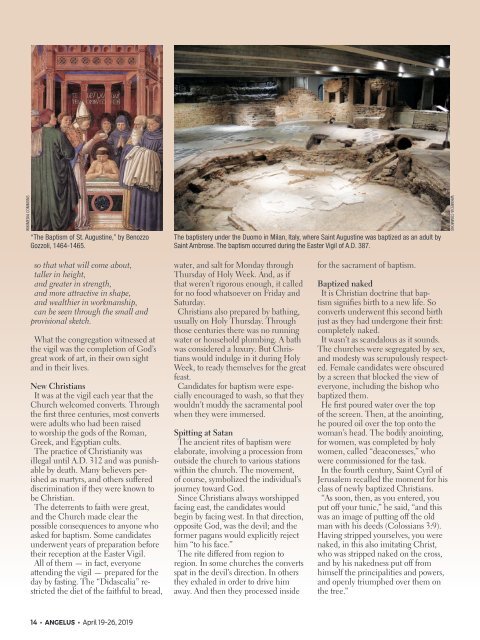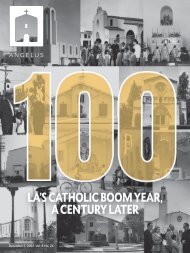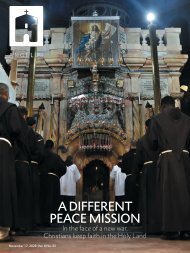Angelus News | April 19-26, 2019 | Vol. 4 No. 15
People hold candles during the Easter Vigil service at Westminster Cathedral on April 4, 2015, in London, England. Also known as the Paschal Vigil, the nocturnal liturgy celebrating the victory of Jesus Christ over death was for early Christians a night full of anticipation and dramatic symbols, rites, and singing. On page 10, contributing editor Mike Aquilina takes us back to the experience of the primitive Church to understand why the vigil was “the night of nights” for those Christians — and why it should still be for us, too. On page 16, Caitlin Yoshiko Kandil speaks to local catechumens about their road to conversion and why they’re looking forward to the “new life” of the baptism they’ll receive at this year’s Easter Vigil.
People hold candles during the Easter Vigil service at Westminster Cathedral on April 4, 2015, in London, England. Also known as the Paschal Vigil, the nocturnal liturgy celebrating the victory of Jesus Christ over death was for early Christians a night full of anticipation and dramatic symbols, rites, and singing. On page 10, contributing editor Mike Aquilina takes us back to the experience of the primitive Church to understand why the vigil was “the night of nights” for those Christians — and why it should still be for us, too. On page 16, Caitlin Yoshiko Kandil speaks to local catechumens about their road to conversion and why they’re looking forward to the “new life” of the baptism they’ll receive at this year’s Easter Vigil.
Create successful ePaper yourself
Turn your PDF publications into a flip-book with our unique Google optimized e-Paper software.
WIKIMEDIA COMMONS<br />
“The Baptism of St. Augustine,” by Benozzo<br />
Gozzoli, 1464-1465.<br />
The baptistery under the Duomo in Milan, Italy, where Saint Augustine was baptized as an adult by<br />
Saint Ambrose. The baptism occurred during the Easter Vigil of A.D. 387.<br />
WIKIMEDIA COMMONS<br />
so that what will come about,<br />
taller in height,<br />
and greater in strength,<br />
and more attractive in shape,<br />
and wealthier in workmanship,<br />
can be seen through the small and<br />
provisional sketch.<br />
What the congregation witnessed at<br />
the vigil was the completion of God’s<br />
great work of art, in their own sight<br />
and in their lives.<br />
New Christians<br />
It was at the vigil each year that the<br />
Church welcomed converts. Through<br />
the first three centuries, most converts<br />
were adults who had been raised<br />
to worship the gods of the Roman,<br />
Greek, and Egyptian cults.<br />
The practice of Christianity was<br />
illegal until A.D. 312 and was punishable<br />
by death. Many believers perished<br />
as martyrs, and others suffered<br />
discrimination if they were known to<br />
be Christian.<br />
The deterrents to faith were great,<br />
and the Church made clear the<br />
possible consequences to anyone who<br />
asked for baptism. Some candidates<br />
underwent years of preparation before<br />
their reception at the Easter Vigil.<br />
All of them — in fact, everyone<br />
attending the vigil — prepared for the<br />
day by fasting. The “Didascalia” restricted<br />
the diet of the faithful to bread,<br />
water, and salt for Monday through<br />
Thursday of Holy Week. And, as if<br />
that weren’t rigorous enough, it called<br />
for no food whatsoever on Friday and<br />
Saturday.<br />
Christians also prepared by bathing,<br />
usually on Holy Thursday. Through<br />
those centuries there was no running<br />
water or household plumbing. A bath<br />
was considered a luxury. But Christians<br />
would indulge in it during Holy<br />
Week, to ready themselves for the great<br />
feast.<br />
Candidates for baptism were especially<br />
encouraged to wash, so that they<br />
wouldn’t muddy the sacramental pool<br />
when they were immersed.<br />
Spitting at Satan<br />
The ancient rites of baptism were<br />
elaborate, involving a procession from<br />
outside the church to various stations<br />
within the church. The movement,<br />
of course, symbolized the individual’s<br />
journey toward God.<br />
Since Christians always worshipped<br />
facing east, the candidates would<br />
begin by facing west. In that direction,<br />
opposite God, was the devil; and the<br />
former pagans would explicitly reject<br />
him “to his face.”<br />
The rite differed from region to<br />
region. In some churches the converts<br />
spat in the devil’s direction. In others<br />
they exhaled in order to drive him<br />
away. And then they processed inside<br />
for the sacrament of baptism.<br />
Baptized naked<br />
It is Christian doctrine that baptism<br />
signifies birth to a new life. So<br />
converts underwent this second birth<br />
just as they had undergone their first:<br />
completely naked.<br />
It wasn’t as scandalous as it sounds.<br />
The churches were segregated by sex,<br />
and modesty was scrupulously respected.<br />
Female candidates were obscured<br />
by a screen that blocked the view of<br />
everyone, including the bishop who<br />
baptized them.<br />
He first poured water over the top<br />
of the screen. Then, at the anointing,<br />
he poured oil over the top onto the<br />
woman’s head. The bodily anointing,<br />
for women, was completed by holy<br />
women, called “deaconesses,” who<br />
were commissioned for the task.<br />
In the fourth century, Saint Cyril of<br />
Jerusalem recalled the moment for his<br />
class of newly baptized Christians.<br />
“As soon, then, as you entered, you<br />
put off your tunic,” he said, “and this<br />
was an image of putting off the old<br />
man with his deeds (Colossians 3:9).<br />
Having stripped yourselves, you were<br />
naked, in this also imitating Christ,<br />
who was stripped naked on the cross,<br />
and by his nakedness put off from<br />
himself the principalities and powers,<br />
and openly triumphed over them on<br />
the tree.”<br />
14 • ANGELUS • <strong>April</strong> <strong>19</strong>-<strong>26</strong>, 20<strong>19</strong>


















